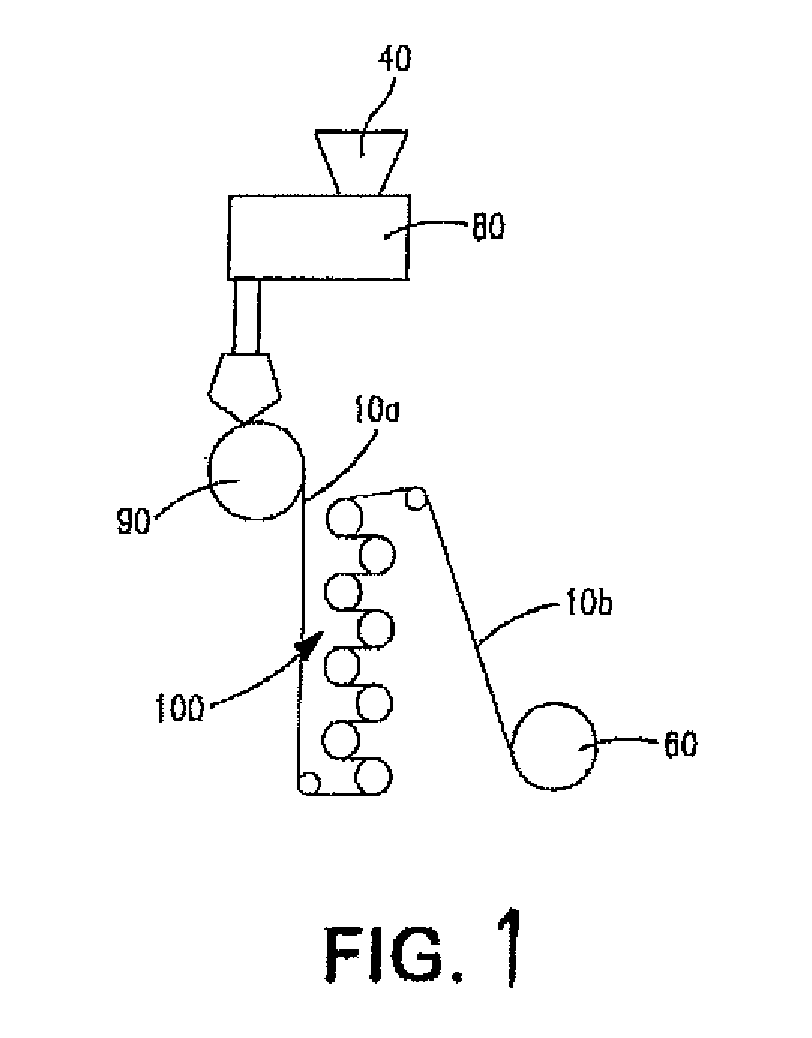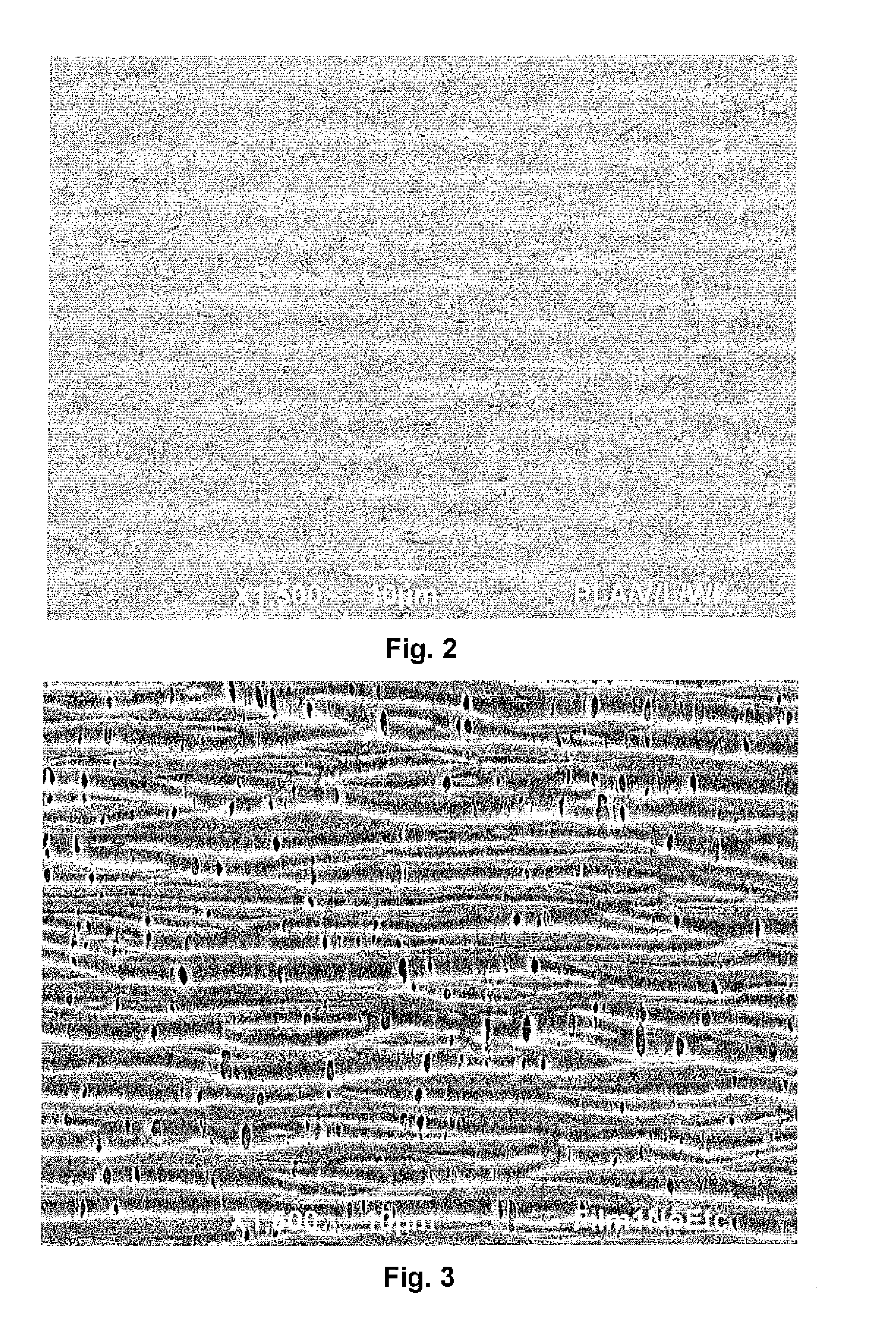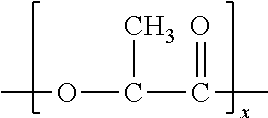Breathable Film Formed from a Renewable Polyester
a technology of renewable polyester and breathable film, which is applied in the direction of lamination, domestic applications, other domestic articles, etc., can solve the problems of noisy rustling, problematic use of renewable polymers in such films, and the lik
- Summary
- Abstract
- Description
- Claims
- Application Information
AI Technical Summary
Benefits of technology
Problems solved by technology
Method used
Image
Examples
example 1
[0116]Films formed from 100% polylactic acid (PLA) were formed as a control by extruding PLA 6201D (Natureworks®, melt flow rate of 10 g / 10 minutes at 190° C.) into a film. The pellets were flood fed into a Rheomix 252 signal screw extruder with a L / D ratio of 25:1 heated to a temperature of about 208° C. where the molten PLA exited through a Haake 6 inch width cast film die and drawn via a Haake take-up roller to a film thickness ranging from 41.9 μm to 48.3 μm.
example 2
[0117]The ability to form films from a blend of 85.3 wt. % polylactic acid (PLA 6201D, Natureworks®) 9.5 wt. % of a toughening additive and 1.4% polyepoxide modifier, and 3.8 wt. % internal interfacial modifier (IIM) was demonstrated. The toughening additive was Vistamaxx™ 2120 (ExxonMobil), which is a polyolefin copolymer / elastomer with a melt flow rate of 29 g / 10 min (190° C., 2160 g) and a density of 0.866 g / cm3. The polyepoxide modifier was poly(ethylene-co-methyl acrylate-co-glycidyl methacrylate) (Lotader® AX8950, Arkema) having a melt flow rate of 70-100 g / 10 min (190° C. / 2160 g), a glycidyl methacrylate content of 7 to 11 wt. %, methyl acrylate content of 13 to 17 wt. %, and ethylene content of 72 to 80 wt. %. The IIM was PLURIOL® W1285 Lubricant Basestock from BASF. The polymers were fed into a co-rotating, twin-screw extruder (ZSK-30, diameter of 30 mm, length of 1328 millimeters) for compounding that was manufactured by Werner and Pfleiderer Corporation of Ramsey, N.J. Th...
example 3
[0119]Films were formed as described in Example 2, except that the film was also stretched in the cross-machine direction to a deformation of 100% at a pull rate of 50 mm / min (deformation rate of 100% / min) with grips at a gage length of 50 mm.
[0120]Various properties of the films of Examples 1-3 were tested as described above. The results are set forth below in Tables 1-2.
TABLE 1Film PropertiesPercentAverageExpansionVoidThicknessRatioVolumeDensityEx.(μm)(φ)(% Vv)(g / cm3)WVTR (g / m2 * 24 hrs.)141.9—n / a1.19241.41.82450.655453334.02.13530.564928
TABLE 2Tensile PropertiesAvg.Avg.Avg.Avg.YieldBreakAvg.Avg. EnergyThicknessModulusStressStressStrain atper Volume atExample(μm)(MPa)(MPa)(MPa)Break (%)Break (J / cm3)1MD44.2253569.560.46.33.3CD46.2245864.750.910.15.12MD44.546641.436.954.616.8CD40.450115.915.962.69.43MD37.326526.726.385.515.8CD34.338625.125.245.89.3
PUM
| Property | Measurement | Unit |
|---|---|---|
| Temperature | aaaaa | aaaaa |
| Temperature | aaaaa | aaaaa |
| Length | aaaaa | aaaaa |
Abstract
Description
Claims
Application Information
 Login to View More
Login to View More - R&D
- Intellectual Property
- Life Sciences
- Materials
- Tech Scout
- Unparalleled Data Quality
- Higher Quality Content
- 60% Fewer Hallucinations
Browse by: Latest US Patents, China's latest patents, Technical Efficacy Thesaurus, Application Domain, Technology Topic, Popular Technical Reports.
© 2025 PatSnap. All rights reserved.Legal|Privacy policy|Modern Slavery Act Transparency Statement|Sitemap|About US| Contact US: help@patsnap.com



